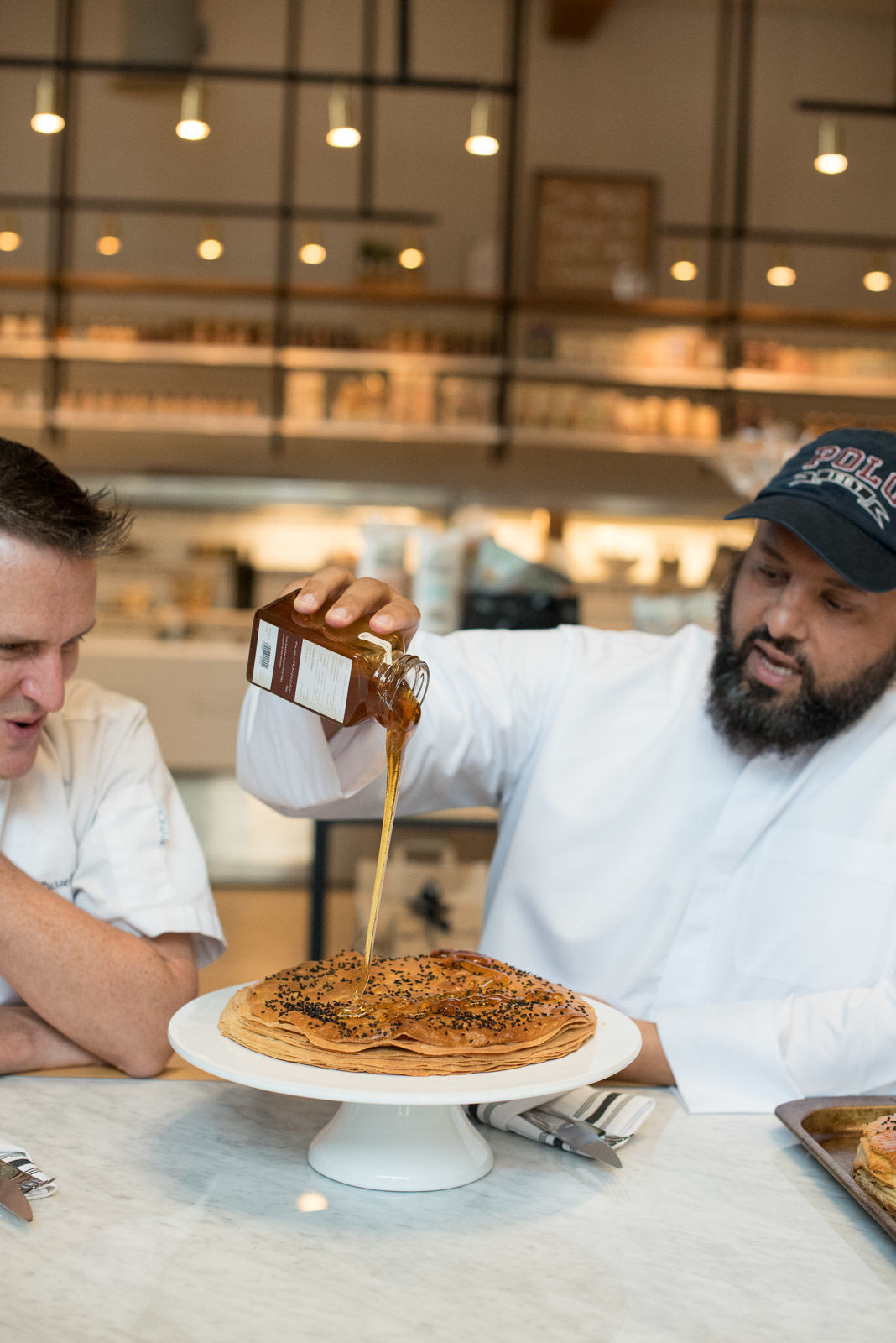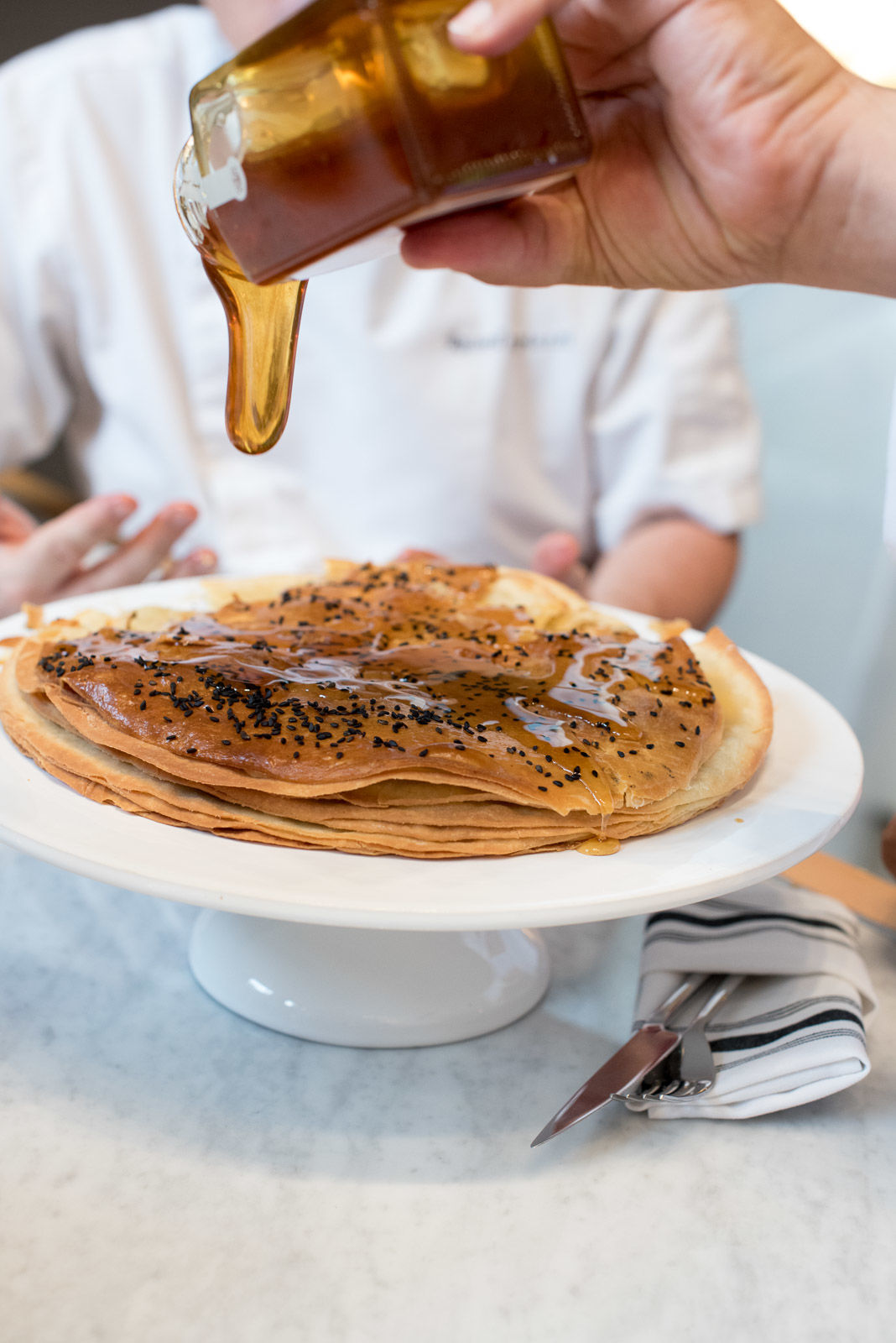ما هي أبرز ذكرياتك عن الطعام منذ الطفولة؟ بدأت تجربتي الأولى في تذوق العسل اليمني عندما كنت طفلة عندما خبزت أمي طبقًا يمنيًا كلاسيكيًا يسمى بنت الصحن. إنها حلوى متعددة الطبقات تشبه الخبز مملوءة بالحبة السوداء (الكمون الأسود). بمجرد خروجها من الفرن تكون مغمورة بعسل السدر اليمني. إن النكهة العميقة والغنية للسدر، مع نكهات الكراميل والتوفي، فوق معجنات مخبوزة ساخنة بالبيض والزبدة لا تُنسى. كنا أنا وإخوتي نستخدم أطراف أصابعنا لتمزيق القطع وتجميعها في كرات محملة بالعسل لوضعها في أفواهنا. لقد تم طبعها في ذاكرتي - في الجزء من الدماغ الذي يحمل كل التجارب التذوقية غير العادية.
تعتبر السبايا نسخة مشابهة من منطقة حضرموت في اليمن، حيث يكون الوسط أكثر كثافة وعجينة. يفضل بعض الناس وضع المزيد من البيض المخفوق على السطح في آخر خمس دقائق من الطهي حتى يتحول إلى اللون الأبيض. يصنع بعض القرويين نوعًا آخر من السبايا ويرشون الزبيب وقليلًا من القرفة بين الطبقات.
بنت الصحن (كعكة العسل اليمني)
حلوى يمنية تقليدية غنية بالزبدة، مكونة من طبقات من العجين الرقيق المرقق ومرشوشة بالعسل. تقدم تقليديا مع الشاي الأسود الساخن. كمية العسل المسكوبة هي مسألة ذوق شخصي ولكنها عادة ما تكون سخية للغاية.
مكونات
- 1 ملعقة صغيرة الخميرة المجففة
- 2-3 ملعقة كبيرة ماء 1/4 كوب
- 560 ج دقيق الخبز الأبيض القوي 4 أكواب
- 4 بيضة كبيرة بالإضافة إلى صفار بيضة واحدة
- 170 ج السمن أو الزبدة المذابة 1 كوب
- 1 ملعقة صغيرة ملح
- زيت نباتي
- 1 ملعقة كبيرة بذور حبة البركة السوداء
- 200 مل عسل يمني خام أو أكثر حسب الذوق
تعليمات
-
نذوب الخميرة في نصف كمية الماء بدرجة حرارة الغرفة، ثم نخلط الدقيق مع 4 بيضات و175 مل من السمن المذاب أو الزبدة والملح وخليط الخميرة مع بعض ونعجنهم لمدة 10-15 دقيقة باليد أو باستخدام خلاط كهربائي مع خطاف العجين، ثم نضيف الماء الإضافي ملعقة صغيرة في كل مرة ونستمر في العجن حتى تصبح العجينة ناعمة وطرية ولا تلتصق باليدين، وقد لا تحتاجين إلى الكمية كلها.
-
غطي العجينة واتركيها ترتاح لمدة 10 دقائق.
-
قومي بتقسيم العجينة إلى 10 قطع باستخدام سكينة دائرية، ثم قومي بتشكيل كل قطعة على شكل كرة ناعمة عن طريق فردها بيديك، ثم ضعيها على صينية الخبز مع ترك مسافات كافية بين كل قطعة وأخرى، ثم ادهنيها بالقليل من الزيت النباتي وغطيها بمنشفة الشاي، واتركي العجينة لترتاح لمدة 30 دقيقة.
-
دهن قالب الكيك المستدير بقطر 36 سم (14 بوصة) بالقليل من الزبدة.
-
رشي القليل من الدقيق على سطح نظيف ومستو. افردي كرة من العجين بيدك، ثم ارفعيها وارميها بين راحتي يدك حتى تبدأ في التمدد - مثل عجينة البيتزا. استخدمي الشوبك لفرد العجين حتى يصبح رقيقًا جدًا بحيث يمكنك الرؤية من خلاله، في شكل دائري خشن. ضعي العجين الممدود بعناية في قاعدة قالب الكيك، ومدي الحواف إلى جانب القالب. ادهني العجين بقليل من السمن أو الزبدة المذابة. كرري هذه العملية لكل كرات العجين العشر، وأضيفي القليل من السمن أو الزبدة المذابة بين الطبقات ولكن ليس على سطح الطبقة الأخيرة.
-
ادهني الطبقة العلوية بصفار البيض المخفوق ثم رشي عليها بذور الحبة السوداء.
-
ضعيها في الفرن المسخن مسبقاً على درجة حرارة 200 مئوية (400 فهرنهايت) لمدة 18-20 دقيقة أو حتى تكتسب الكعكة اللون البني الذهبي.
-
بينما لا تزال الكعكة دافئة، اسكبي العسل الخام على سطح الكعكة بسخاء. لا تقطعيها - من المعتاد تناولها باستخدام أصابعك.
- رياض يسكب عسل السدر اليمني على بنت الصحن الطازجة
- سكب العسل اليمني الخام على الكيكة وهي لا تزال دافئة من الفرن

الشيف راسل إمبيازي ورياض حامد من بلقيس يتناولان طبق بنت الصحن
هل سبق لك أن تذوقت كعكة العسل اليمنية؟ ما هي ذكرياتك عن الطعام في طفولتك؟ إذا استخدمت هذه الوصفة، فيرجى إخباري بالنتيجة.











